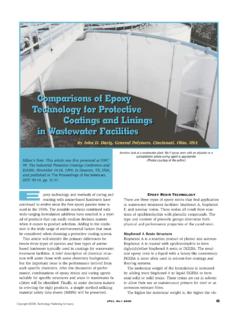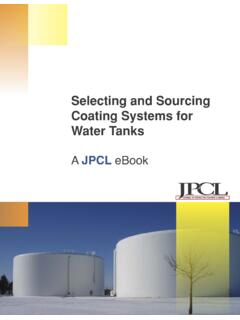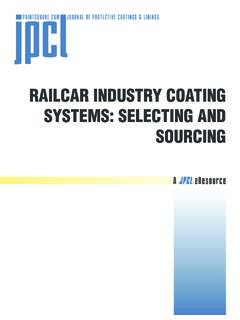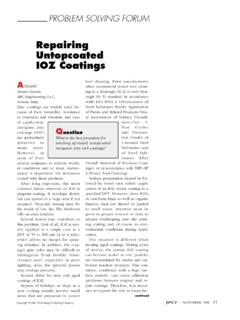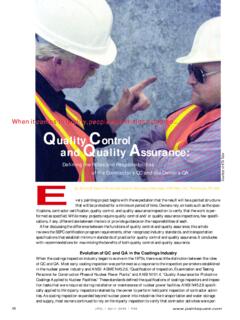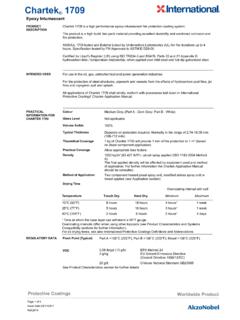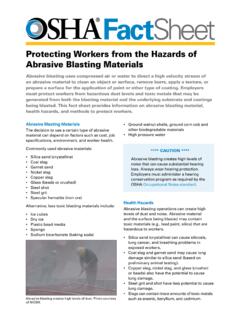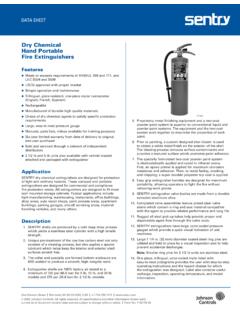Transcription of Quality Control of Abrasive Blast Cleaning Operations
1 Quality Control of Abrasive Blast Cleaning Operations William D. Corbett KTA-Tator, Inc. Introduction Webinar Content: Overview of dry Abrasive Blast Cleaning Operations Introduction to industry standards for Abrasive Blast Cleaning Quality of equipment and Abrasive media Establishing process Control to monitor Quality Effect of ambient conditions on final Abrasive Blast Cleaning Surface Cleanliness Surface profile and roughness Post- Blast dust inspection Learning Objectives/Outcomes Completion of this webinar will enable the participant to: Describe the industry standards that pertain to dry Abrasive Blast Cleaning Describe the methods used to verify the Quality of Abrasive Blast Cleaning equipment and abrasives Establish process controls to monitor Quality Document environmental conditions prior to final Abrasive Blast Cleaning Evaluate surface cleanliness Measure surface profile and roughness Assess surface dust Overview of Dry Abrasive Blast Cleaning Operations Purpose: Clean and roughen new and existing surfaces Responsibility for Quality : Contractor: Control Quality (and production) Facility Owner.
2 Assure Quality Introduction to Industry Standards for Abrasive Blast Cleaning ASTM Abrasive Cleanliness Standards ASTM Compressed Air Cleanliness Standard ASTM Surface Profile/Roughness Measurement Standards ISO Dust Assessment Standard SSPC Abrasive Standards SSPC/NACE Surface Cleanliness Standards SSPC Surface Profile Measurement Frequency Standard (draft) Quality of Abrasive Blast Cleaning Equipment Maintain Project Schedule (production) Compressor Capacity Blast Nozzle Wear Blast Nozzle Air Pressure Maintain Quality Verify Clean, Dry Compressed Air Quality of Abrasive Blast Cleaning Equipment Compressor Capacity Requirements based on multiple factors/conditions No. of operators, nozzle sizes and required pressure are important considerations Equipment manufacturers publish charts for guidance Quality of Abrasive Blast Cleaning Equipment Monitoring Blast Nozzle Wear Abrasive wears opening, reducing productivity Wear monitored using Pressure Blast Analyzer Gauge (nozzle orifice gauge) Quality of Abrasive Blast Cleaning Equipment Monitoring Blast Nozzle Pressure Reduction in nozzle pressure reduces productivity Pressure monitored using hypodermic needle pressure gauge Quality of Abrasive Blast Cleaning Equipment Monitoring Compressed Air Cleanliness Oil or water in compressed air can contaminate Abrasive and surfaces Blotter Test performed per ASTM D 4285 Requirement of SSPC Abrasive Blast Cleaning Standards Quality of Abrasive Media SSPC-AB 1 (Mineral & Slag Abrasives)
3 SSPC-AB 2 (Cleanliness of Recycled Abrasive ) SSPC-AB 3 (Ferrous Metal Abrasives) SSPC-AB 4 (Recyclable Encapsulated Media) SSPC-AB 1 Specification for Mineral & Slag Abrasives Categorizes by Type, Class and Grade Type I: Natural mineral Type II: Slag Class A: <1% crystalline silica Class B: <5% crystalline silica Class C: Unrestricted crystalline silica Grade 1: mil Grade 2: mils Grade 3: mils Grade 4: mils Grade 5: mils SSPC-AB 1 Specification for Mineral & Slag Abrasives Testing for conformance Specific gravity Hardness Weight change on ignition Water soluble contaminants* Moisture content Oil content* Crystalline silica content Surface profile yield* Particle size distribution (sieve analysis) * Abrasive cleanliness invoked by SSPC Abrasive Blast Cleaning Standards Specifications for Metallic Abrasives SSPC-AB 2 Cleanliness of recycled metallic abrasives* Testing for conformance Non- Abrasive residue Lead content (laboratory only) Water soluble contaminants Oil content * Abrasive cleanliness invoked by SSPC Abrasive Blast Cleaning Standards Specifications for Metallic Abrasives SSPC-AB 3 Categorizes by Class Class 1: Steel Class 2.
4 Iron Testing for conformance Abrasive size Specific gravity Chemical composition Hardness Durability Cleanliness* Conductivity* * Abrasive cleanliness invoked by SSPC Abrasive Blast Cleaning Standards SSPC-AB 4 Recyclable Encapsulated Abrasive Media (Sponge) Alternative in applications where dust Control is important Can reduce risk of damage to sensitive surroundings Type of media in composite will affect Cleaning Quality Classifier effectiveness Oil and conductivity Quality of Abrasive Media Abrasive Cleanliness Automatically invoked by SSPC Surface Cleanliness Standards Oil per ASTM D 7393 Vial test No visually detectable oil Quality of Abrasive Media Abrasive Cleanliness Conductivity per ASTM D 4940 Vial test No prescribed frequency Threshold per SSPC AB standards is 1000 S/cm Automatically invoked by SSPC Surface Cleanliness Standards Establishing Process Control to Monitor Quality Purpose of a project-specific standard Documentation of critical variables Assessment of surface cleanliness and profile yield Preservation Establishing Process
5 Control to Monitor Quality Purpose of a project-specific standard Represents the degree of cleanliness using the actual initial condition of the steel Establishes the expectation of cleanliness prior to production work Establishes the surface profile yield prior to production work Serves as a reference throughout the project Establishing Process Control to Monitor Quality Assessment of surface cleanliness and profile yield Measure surface profile using appropriate method (described later) Measure peak count (if required) Assess whether surface cleanliness was achieved using SSPC VIS 1 Guide (described later) Establishing Process Control to Monitor Quality Documentation of Critical Variables Blast nozzle type Blast nozzle size Abrasive manufacturer Abrasive type Abrasive size Air pressure at nozzle Nozzle distance to surface Nozzle angle to surface Blast hose length Blast hose diameter Compressor size (CFM) Air pressure at compressor Surface profile yield (in mils or micrometers) Relative Peak Count (if specified) Establishing Process Control to Monitor Quality Preserving the Project-Specific Standard May need to reference later in the project Seal in non-glossy clear coat Digital high resolution image (photograph) Environmental Conditions for Surface Preparation Rough surface preparation work can occur when conditions are less than desirable (unless prohibited by contract)
6 Final surface preparation work should occur when conditions preclude moisture formation on prepared surfaces Measuring Ambient Conditions Prior to Final Surface Preparation If air temperature and relative humidity are such that moisture from the air condenses on the surface, the surface may rust bloom, or rust back prior to coating Recommend verifying that the temperature of the surface is at least 5 F (3 C) higher than the dew point temperature to preclude condensation (requirement may be invoked by specification) Significance of 5 F (3 C) Theoretically, a small (<1 F) increase (surface temperature over dew point) will preclude moisture formation Minimum increase of 5 F (3 C) compensates for: Instrument tolerances Varying conditions Changing conditions Dehumidification Dehumidification (DH) equipment removes air moisture, reducing opportunity for condensation Conditions monitored using computer software (component to DH equipment) or by manual measurements SSPC/NACE Joint Technical Report SSPC-TR3/NACE 6A192, Dehumidification and Temperature Control During Surface Preparation, Application and Curing for Coatings/Linings of Steel Tanks, Vessels and other Enclosed Spaces Dehumidification, con t.
7 DH accomplished by: Compression Refrigeration Desiccation (liquid or solid sorption) Combination of methods listed Refrigeration and desiccation (solid sorption) most common for field work Surface Cleanliness Pre- Blast : SSPC-SP 1 (Solvent Cleaning ) Post- Blast : SSPC-SP7/NACE 4, Brush-Off Blast Cleaning SSPC-SP14/NACE 8, Industrial Blast Cleaning SSPC-SP6/NACE 3, Commercial Blast Cleaning SSPC-SP10/NACE 2, Near-White Metal Blast Cleaning SSPC-SP5/NACE 1, White Metal Blast Cleaning SSPC-SP16, Brush-Off Blast Cleaning of Coated and Uncoated Galvanized Steel, Stainless Steels, and Non-Ferrous Metals Using SSPC VIS 1 Governing document For dispute resolution, the written standard is the governing document; visuals are guides to the written standards SSPC-SP 1 Solvent Cleaning Requires the removal of all visible grease, oil, lubricants, and cutting compounds from the surface Performed prior to mechanical methods of preparation An automatic requirement to most SSPC surface cleanliness standards (except SSPC-SP 13) SSPC-SP 7/NACE No.
8 4 Brush-Off Blast Cleaning Requires sweep blasting the entire surface to remove loose rust, loose mill scale, and loose paint Tightly adherent material may remain Dull putty knife used to determine if remaining material is loose or tight Viewed without magnification SSPC-SP 14/NACE No. 8, Industrial Blast Cleaning Requires removal of all loose rust, loose mill scale, and loose paint Traces of intact mill scale, intact rust, and intact paint may remain on up to 10% of each 9 in2 of surface; stains are permitted on the remainder of the 9 in2 Dull putty knife used to determine if remaining material is loose or tight Limited access areas are exempt from the 10% restrictions on intact material intact material may remain provided the entire area is subjected to the Abrasive Blast Viewed without magnification SSPC-SP 6/NACE No.
9 3, Commercial Blast Cleaning Requires removal of all mill scale, rust and paint Staining from rust, paint and mill scale permitted, but must be evenly dispersed Staining cannot exceed 33% of each 9 in2 of prepared surface Viewed without magnification SSPC-SP10/NACE No. 2, Near-White Blast Cleaning Requires removal of all mill scale, rust and paint from the surface Staining from rust, paint and mill scale is permitted to remain, but must be evenly dispersed Staining cannot exceed 5% of each 9 in2 of prepared surface Viewed without magnification SSPC-SP 5/NACE No. 1, White Metal Blast Cleaning Requires removal of all mill scale, rust and paint from the surface Staining from rust, paint and mill scale are not permitted to remain Viewed without magnification Does not mean that the surface will be free of shadows to evaluate, change viewing angle or lighting angle SSPC-SP 16, Brush-Off Blast Cleaning of Coated and Uncoated Galvanized Steel, Stainless Steels and Non-Ferrous Metals Not for carbon steel Requires sweep blasting the entire surface to remove all foreign matter.
10 Paint may remain if it is tightly adherent Dull putty knife used to determine if remaining paint is loose or tight Dense and uniform surface profile is required Viewed without magnification Using SSPC-VIS 1 Guide Reference photographs are divided into 4 sections: of SSPC-SP7, SP6, SP10, and SP5 on steel that has never been painted of SSPC-SP5 produced with different metallic and non-metallic abrasives of SSPC-SP7, SP14, SP6, SP10, and SP5 on previously painted steel of surface profile depth, angle of view, and lighting on the appearance of SSPC-SP5 Prior to 1989, SSPC used the Swedish Standards (now ISO 8501-1) SSPC-VIS 1 Initial Conditions Photographs represent the appearance of surfaces both prior to and after Abrasive Blast Cleaning Surface conditions depicted prior to Cleaning : Previously unpainted Condition A - Intact mill scale Condition B - Rust and mill scale Condition C - Totally rusted Condition D - Totally rusted and pitted Previously painted Condition G1 Aged coating with extensive pinpoint rusting Condition G2 Aged coating with moderating pitting Condition G3 Aged coating with severe pitting SSPC-VIS 1 Depictions of Cleaning Degrees of Cleaning depicted for previously unpainted steel: SSPC-SP 7, Brush-Off Blast Cleaning SSPC-SP 6, Commercial Blast Cleaning SSPC-SP 10, Near-White Metal Blast Cleaning SSPC-SP 5, White Metal Blast Cleaning Degrees of Cleaning depicted for previously painted steel: All of the above, plus SSPC-SP 14, Industrial Blast Cleaning No photographs available.

